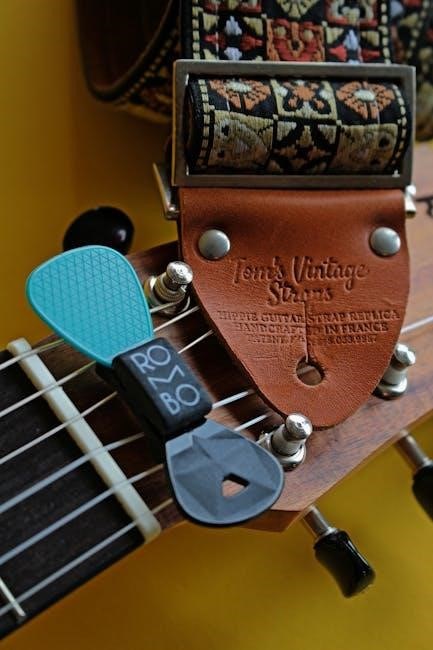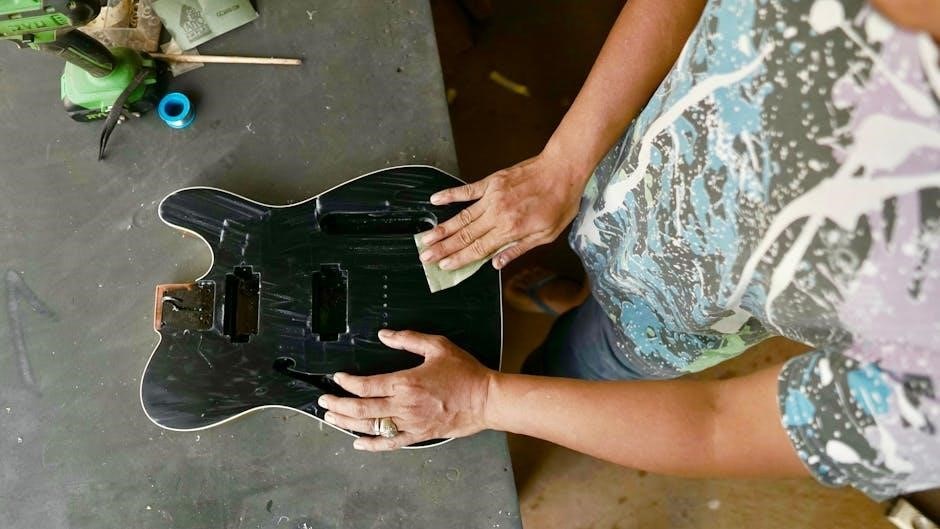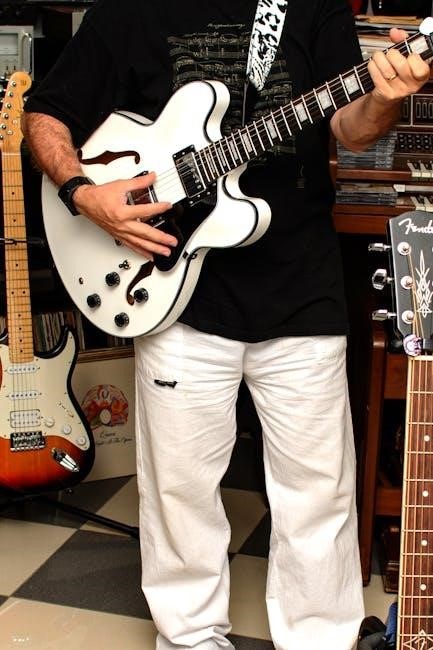The Guitar Player Repair Guide is an essential resource for musicians, offering step-by-step solutions for basic adjustments and minor repairs, empowering players to maintain their instruments effectively.
Why Guitar Repair and Maintenance are Important
Regular guitar repair and maintenance are crucial for preserving the instrument’s playability and sound quality. Neglecting these tasks can lead to issues like fret buzz, tuning instability, and electronic malfunctions, which may require costly professional fixes. By addressing problems early, such as adjusting the truss rod or cleaning the fingerboard, players can prevent major damage and ensure their guitar remains in optimal condition. Maintenance also enhances the overall performance, making it easier to play and enjoy. Investing time in basic setups and care extends the guitar’s lifespan and maintains its value, ensuring it continues to inspire creativity and music-making for years to come.
Basic Tools and Resources for Guitar Repair
Equipping yourself with the right tools is essential for effective guitar repair. A set of flat- and cross-head screwdrivers, Allen keys, and pliers with wire cutters are indispensable. A string winder simplifies restringing, while a soldering iron and multimeter handle electronic fixes. Guitar-specific tools like a truss rod wrench and nut files are also vital. Additional resources include guitar lube, wood polish, and fingerboard conditioner to maintain the instrument’s finish and playability. A comprehensive guide, such as the Guitar Player Repair Guide, provides step-by-step instructions and factory specifications for DIY repairs, ensuring you’re well-prepared to tackle common issues and keep your guitar in great shape.

Guitar Setup Guide
A proper guitar setup enhances playability and sound quality. Adjust the neck, string action, and intonation for optimal performance, ensuring your guitar feels and sounds its best.
Neck Adjustment and Truss Rod Basics
Neck adjustment is crucial for proper guitar playability. The truss rod adjusts the neck’s bow, counteracting string tension. Turning the rod clockwise straightens the neck, while counterclockwise adds relief. Before making adjustments, ensure the guitar is tuned to pitch. Use an Allen wrench to tighten or loosen the truss rod nut, checking progress with a straightedge or capo. Over-tightening can damage the neck, so proceed cautiously. A slight bow (0.010″ to 0.015″) is ideal for most guitars, allowing smooth playability without fret buzz. Regular adjustments may be needed due to humidity changes or string gauge modifications.

Setting String Action for Optimal Playability
String action, or the distance between the strings and fretboard, is crucial for playability and tone. A low action reduces finger fatigue but risks fret buzz, while high action improves clarity yet makes playing harder. Measure action at the 12th fret using a ruler: 4/64″ for the low E and 3/64″ for the high E are typical. Adjust the bridge or nut to achieve this. After adjustments, tune the guitar and play to ensure proper performance. Small changes can significantly impact feel and sound, so proceed carefully to avoid over-adjustment. Proper string action balances comfort and clarity, enhancing overall playing experience.
Filing Nut Slots and Adjusting Intonation
Filing nut slots ensures proper string height and alignment, preventing tuning issues. Use a precision file matched to the string gauge, carefully widening slots if necessary. Be cautious to avoid over-filing, as this can lower action too much. Adjusting intonation involves fine-tuning the string length at the bridge. Use a screwdriver to move the saddle forward or backward, ensuring each string plays in tune up the neck. Check octaves and harmonics for accuracy. Proper intonation and nut slot alignment are vital for clear, consistent tone across the fretboard, enhancing playability and sound quality. These adjustments require patience and precision for optimal results.

DIY Guitar Repairs
Common issues like loose jacks, fret buzz, and pickup adjustments can often be fixed with basic tools. Empowers guitarists to save money and time.

Common Issues and Simple Fixes
Guitarists often encounter issues like loose jacks, fret buzz, or pickup adjustments. These problems can be resolved with basic tools and a little patience. For loose jacks, tighten the screws or replace the jack if damaged. Fret buzz can be addressed by adjusting the truss rod or raising the string action. Pickup height adjustments can improve tone clarity. Other common fixes include cleaning dirty electronics, tightening loose tuners, and restringing the guitar properly. These simple solutions save time and money, avoiding the need for professional help. Always use the right tools, like screwdrivers, pliers, and soldering irons, to ensure effective repairs. Regular maintenance can prevent many of these issues from arising.

Replacing Tuners and Hardware
Replacing tuners and hardware is a straightforward process that enhances your guitar’s functionality and aesthetics. Choose tuners that match your guitar’s setup, such as 3×3 for Les Paul-style or 6-in-line for Stratocaster-type headstocks. Remove the old tuners by unscrewing them, then install the new ones, ensuring proper alignment. Tighten securely but avoid over-tightening. For other hardware like bridges or knobs, select replacements that fit your guitar’s make and model. Use tools like screwdrivers, pliers, and Allen keys for precise adjustments. Upgrading hardware can improve tuning stability, playability, and overall performance. Always follow manufacturer guidelines to ensure compatibility and optimal results. This DIY fix can breathe new life into your instrument. Regular maintenance ensures smooth operation and prevents wear. A professional setup after installation guarantees the best results. Keep your guitar sounding and playing its best with these simple upgrades. Proper installation prevents future issues, saving time and money. DIY repairs empower you to customize and maintain your guitar effectively.
Fixing Fret Buzz and Electronic Problems
Fret buzz and electronic issues are common problems that can hinder your guitar’s performance. Fret buzz often results from low string action or uneven frets. To fix it, adjust the neck using the truss rod or raise the string action at the bridge. If frets are worn, a professional fret leveling may be needed. For electronic problems, check connections, solder joints, and pickups. Clean or replace faulty pots, switches, or jacks. Use a multimeter to diagnose wiring issues. Replacing pickups or electronics can enhance tone and reliability. Regularly cleaning and inspecting your guitar’s electronics prevents corrosion and ensures optimal functionality. Addressing these issues promptly ensures clear, uninterrupted sound and smooth playability, keeping your guitar in top condition for years to come. DIY fixes can save costs and extend your instrument’s lifespan. Always use quality tools and materials for durable repairs. Proper maintenance and timely fixes preserve your guitar’s value and performance. Regular checks and simple adjustments can prevent major issues from arising. By understanding and addressing these problems, you can enjoy a responsive and sounding guitar. Keep your instrument playing smoothly with these essential fixes. Consistent care ensures your guitar remains a reliable musical companion.

Guitar Maintenance Tips
Regular maintenance ensures your guitar stays playable and looking great. Clean the body, condition the fingerboard, and replace strings often. Use wood polish and proper tools for care.
Cleaning and Polishing the Guitar Body
Cleaning and polishing are crucial for maintaining the guitar’s appearance and protecting its finish. Start by removing dirt and grime using a soft cloth and mild guitar-specific cleaner. Avoid harsh chemicals or household products that can damage the finish. For polished finishes, use a guitar polish to restore shine and protect the surface. Apply the polish with a clean, lint-free cloth in circular motions. For matte finishes, a damp cloth followed by a dry one suffices. Regular cleaning prevents buildup and keeps the guitar looking new. Always test a small area first to ensure the products won’t damage the finish.
Conditioning the Fingerboard and Applying Wood Polish
Conditioning the fingerboard is essential for maintaining playability and preventing drying or cracking. Use a high-quality wood conditioner or fingerboard oil, such as lemon oil or tung oil, to hydrate the wood. Apply a small amount with a soft cloth, working in the direction of the wood grain. Allow it to sit for a few minutes before wiping off excess. For polished finishes, apply wood polish with a clean cloth in circular motions. Regular conditioning ensures the fingerboard remains smooth and responsive. Avoid over-application to prevent a sticky surface. This routine keeps the fingerboard healthy and enhances the overall feel of the guitar.
Regular String Replacement and Tuning
Regular string replacement is crucial for maintaining tone and playability. Old strings lose brightness and can cause tuning issues. Replace strings every 3-4 months or when they show signs of wear. Use a string winder to remove old strings and install new ones, ensuring the correct gauge for your guitar. Stretch new strings by gently pulling them away from the fretboard to stabilize tuning. Tune your guitar frequently, ideally after each string change and before playing. Use a tuner for accuracy, and consider using a metronome to improve your playing. Proper string care extends the life of your strings and keeps your guitar sounding its best. Consistent tuning also prevents damage to the neck and bridge. Regular maintenance ensures optimal performance and longevity of your instrument.

Troubleshooting Common Guitar Problems
Identify issues like fret buzz, tuning instability, or electronic malfunctions. Use diagnostic tools to pinpoint problems, ensuring accurate repairs and maintaining your guitar’s optimal performance and sound quality.
Identifying Issues with the Neck and Electronics
Neck problems often include warping or improper alignment, affecting playability. Check for fret buzz or uneven frets, which may indicate a truss rod adjustment is needed. For electronics, issues like crackling pots, loose connections, or faulty pickups can disrupt sound quality. Use a multimeter to test wiring and components. Regular cleaning of electronics with lighter fluid or guitar lube can prevent corrosion and ensure smooth operation. Addressing these issues early prevents further damage and maintains your guitar’s performance. Regular maintenance and inspections are crucial for long-term reliability and optimal sound quality.

Advanced Troubleshooting for Persistent Problems
Persistent issues may require deeper investigation, such as diagnosing complex electrical faults or structural damage. For recurring neck problems, precise truss rod adjustments or even a neck reset might be necessary. Electronics troubleshooting could involve rewiring or replacing components like pickups, pots, or capacitors. Advanced tools like soldering irons and multimeters are essential for these repairs. Consulting detailed guides or seeking professional help from a luthier can provide tailored solutions. Addressing these challenges ensures your guitar remains playable and sounding its best, even when faced with stubborn or intricate problems that go beyond basic maintenance.
Mastering guitar repair and maintenance ensures longevity and optimal performance. Regular care, DIY fixes, and professional interventions when needed will keep your instrument sounding and playing its best.
Final Tips for Keeping Your Guitar in Great Shape
Regular maintenance is key to preserving your guitar’s quality. Clean the body and fingerboard frequently, using appropriate polishes to prevent damage. Replace strings regularly to maintain tone and playability. Store your guitar in a dry, cool environment to avoid warping or cracking. For adjustments, consider consulting a professional when unsure. Keep essential tools handy, such as a string winder and Allen keys, to tackle minor issues promptly; By following these practices, you can ensure your guitar remains in optimal condition, providing years of enjoyable playing and performance.
